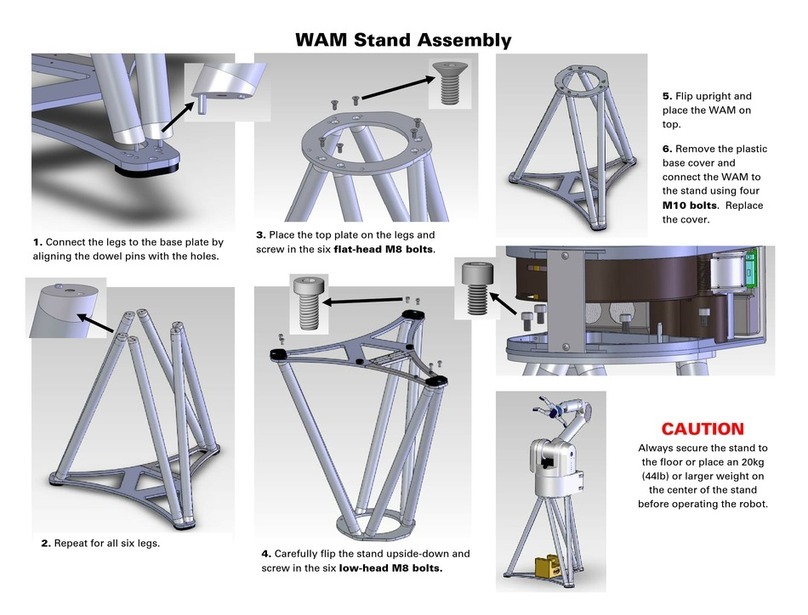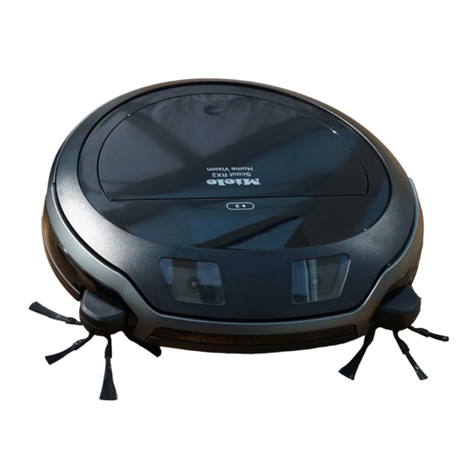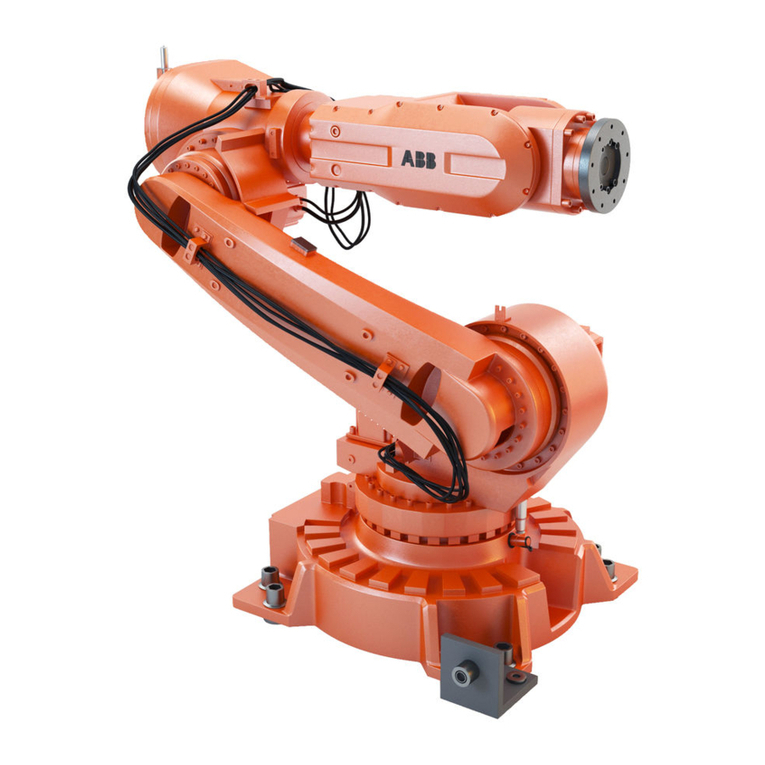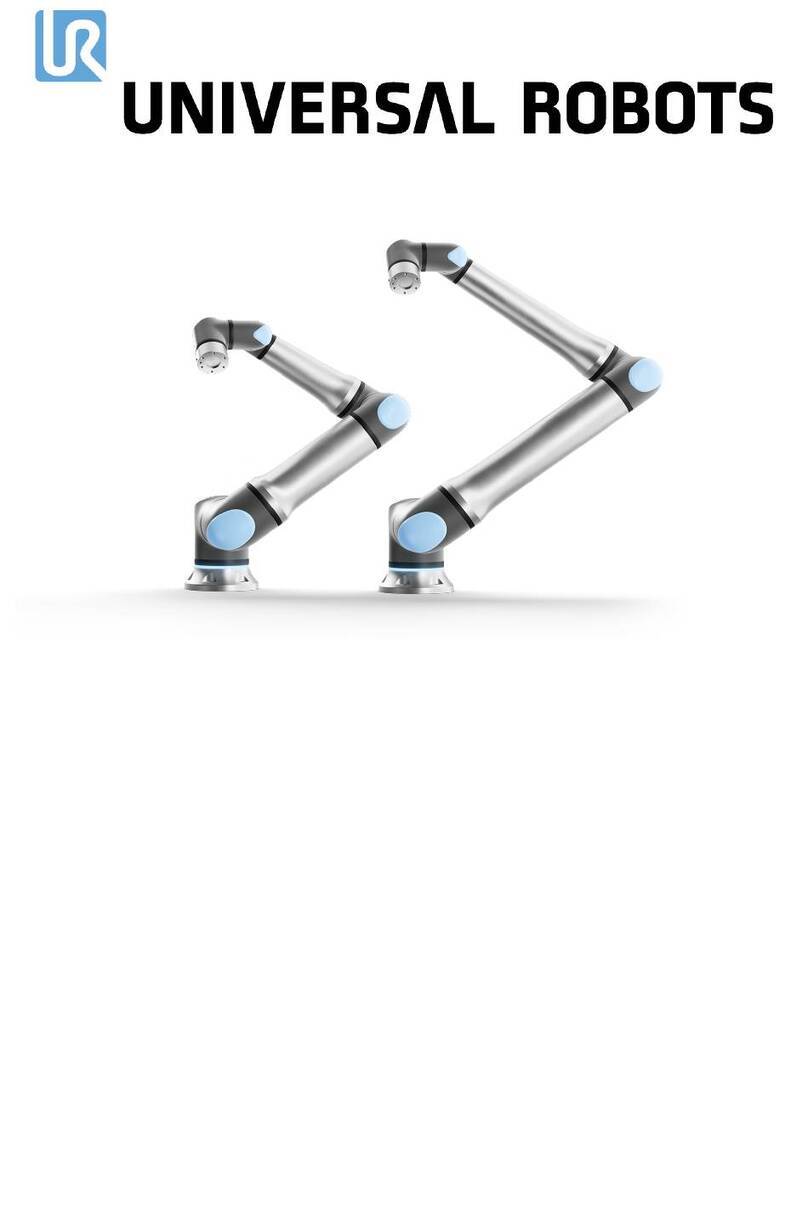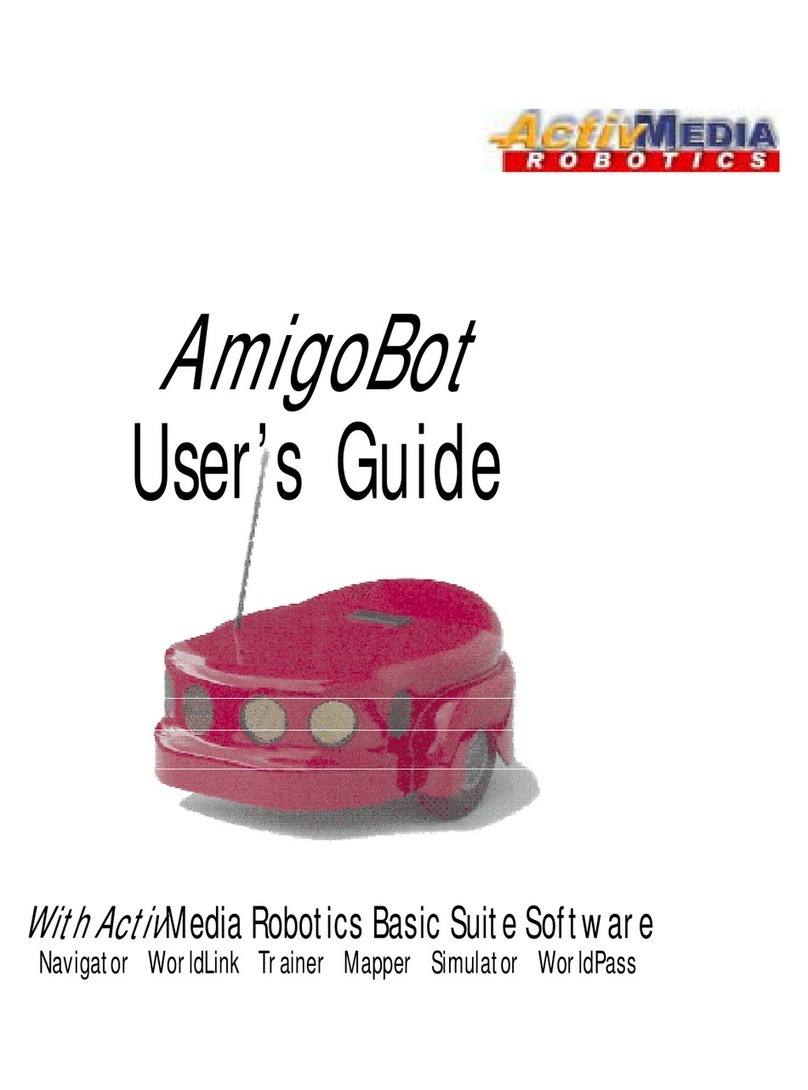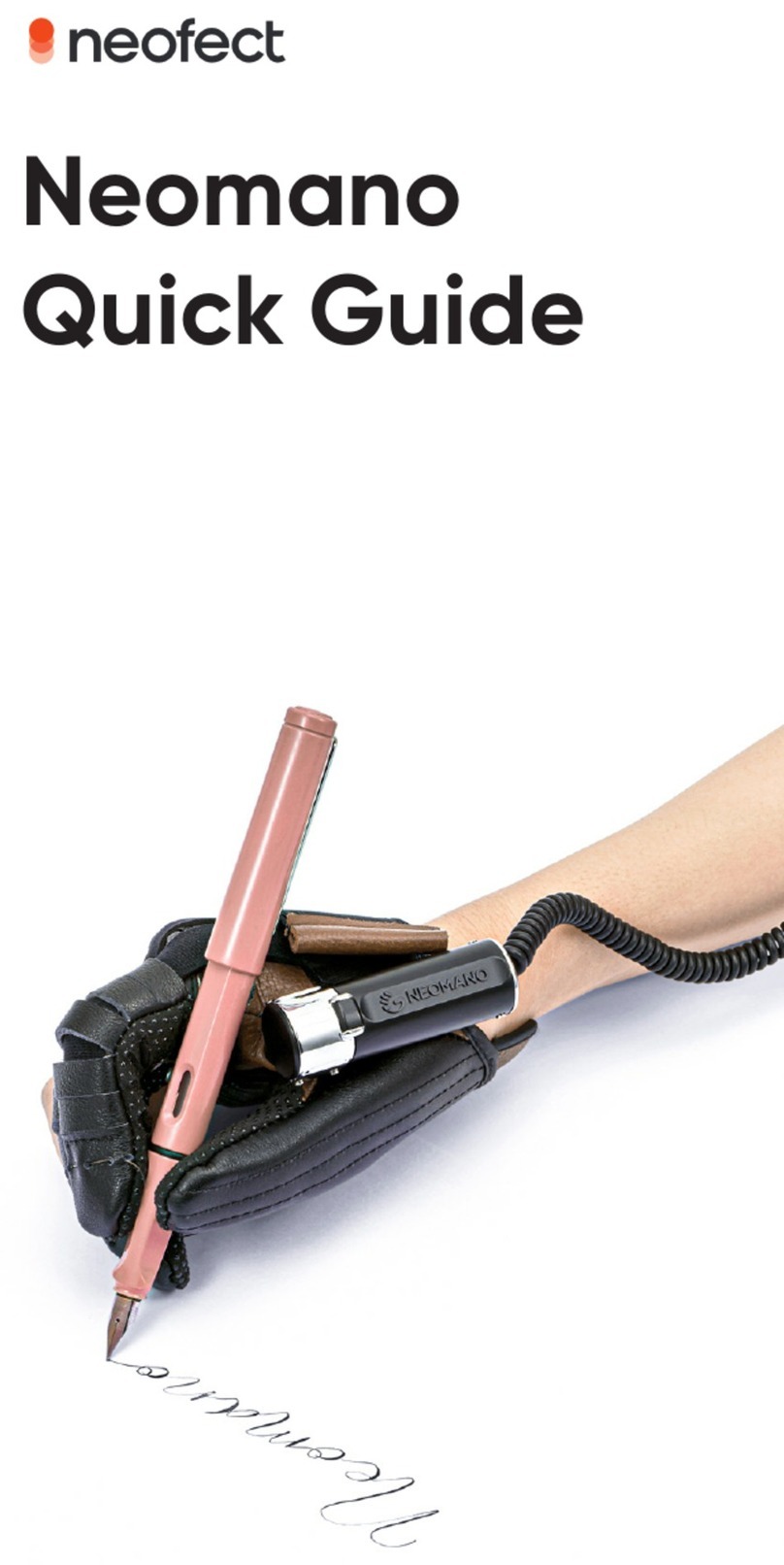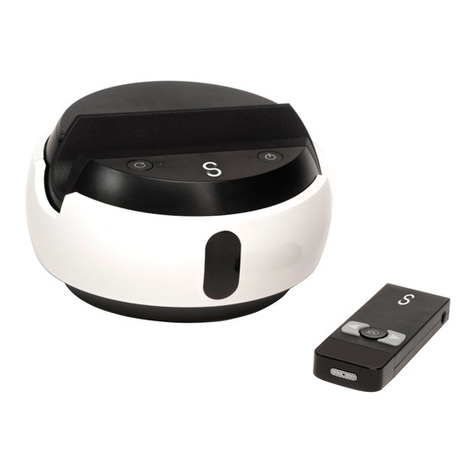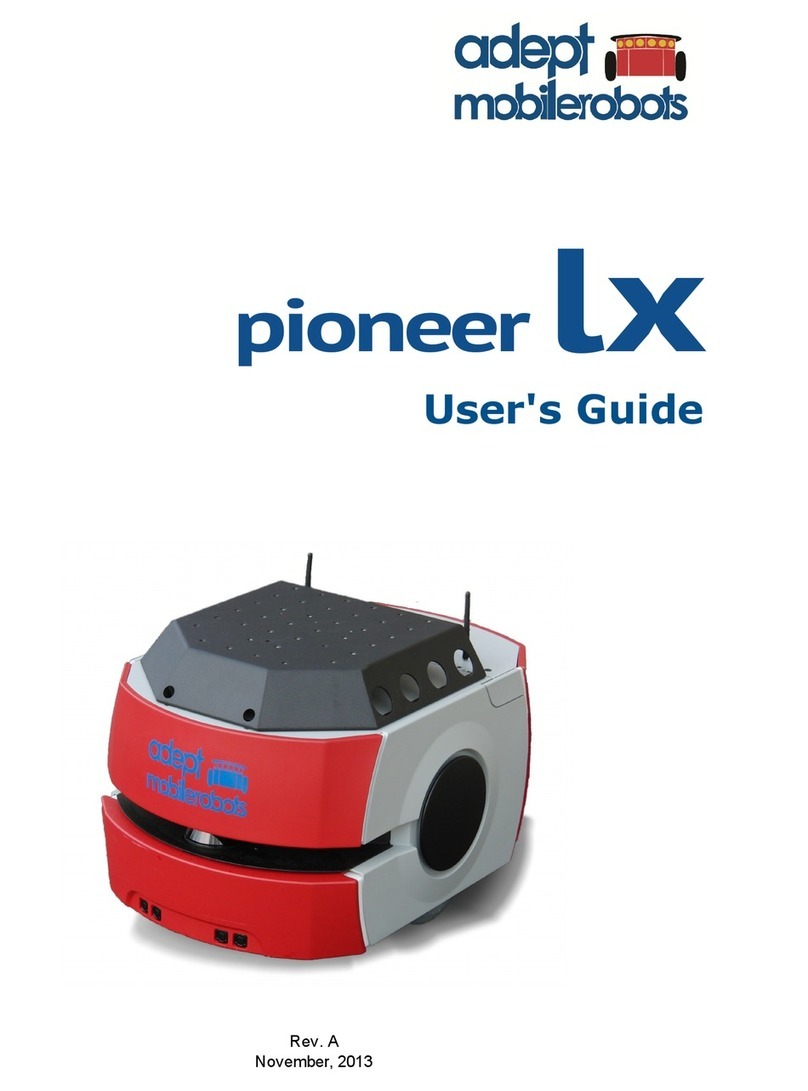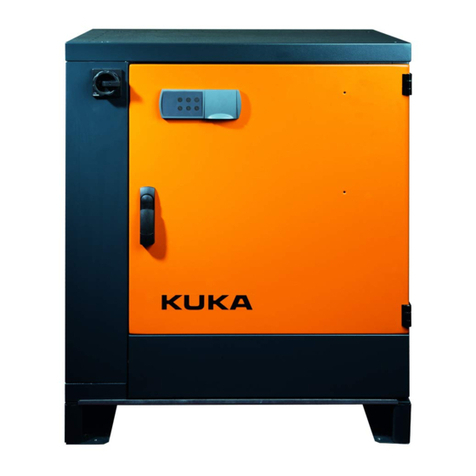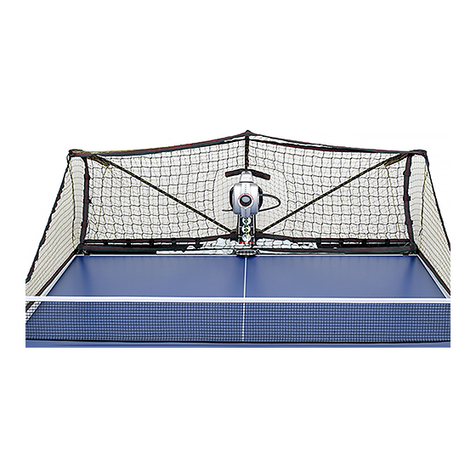DH CGC-80 How to use

CGC-80 Gripper
Short Manual
Content
Revisions...........................................................................................................................................1
1 Specifications.................................................................................................................................2
1.1 Performance Parameter.......................................................................................................2
1.2 Indicator ..............................................................................................................................4
1.3 Dimensions..........................................................................................................................4
1.4 Standard flange ...................................................................................................................5
1.5 Pinout Description...............................................................................................................5
2 Modbus-RTU Control ....................................................................................................................6
2.1 Wiring .................................................................................................................................6
2.2 Default Communication Parameters ...................................................................................6
2.3 Modbus-RTU Description...................................................................................................7
2.3.1 RTU Framing ...........................................................................................................7
2.3.2 Supported Modbus Function Code...........................................................................7
2.3.3 Register Mapping.....................................................................................................7
2.3.4 Register Description.................................................................................................9
2.3.4.1 Initialization ..................................................................................................9
2.3.4.2 Force..............................................................................................................9
2.3.4.3 Position........................................................................................................10
2.3.4.4 Speed...........................................................................................................10
2.3.4.5 Initialization State .......................................................................................11
2.3.4.6 Gripper State ...............................................................................................11
2.3.4.7 Current Position ..........................................................................................12
2.3.4.8 Save Parameter............................................................................................12
2.3.4.9 Initialization Direction ................................................................................12
2.3.4.10 Slave Address............................................................................................13
2.3.4.11 Baud Rate ..................................................................................................13
2.3.4.12 Stop Bits....................................................................................................14
2.3.4.13 Parity .........................................................................................................14
2.3.4.14 Test I/O Parameters ...................................................................................15
2.3.4.15 I/O Mode Switch.......................................................................................15
2.3.4.16 I/O Parameter Configuration.....................................................................16
3 I/O Control...................................................................................................................................18
3.1 Wiring ...............................................................................................................................18
3.2 I/O Setting.........................................................................................................................19
3.2.1 Configure IO ..........................................................................................................19

2
3.2.2 Open IO..................................................................................................................20
3.2.3 Save Settings..........................................................................................................20
3.2.4. Restart ...................................................................................................................20

1
Revisions
Date
Version
Revised content
20200426
V1.0
First edition, write wiring instructions and
command instructions
20200904
V2.0
Change some instructions , Update the description
of IO mode

2
1 Specifications
CGC series are collaborative electric gripper, The number(CGC-number) represents the
maximum gripping force of the gripper. The gripper is equipped with a pair of parallel fingertips,
which runs symmetrically during the movement. The main structure of the gripper is a smooth
rectangular structure. It is equipped with an 8-core communication interface, as shown in Figure 1.1.
It has the following characteristics:
Controllable force/position/speed: The gripper can program and adjust the grip position,
grip force and speed.
Multiple communication modes: The gripper supports Modbus RTU protocol and IO mode
control. Other communication protocols such as Ethernet and ETHERNET can be transferred
through protocol converter.
Gripping Detection: The combination of force control and position control is adopted in the
gripping process.
Gripping feedback: The state of the gripper can be read by programming, and can also be
judged according to the indicator of the gripper.
Fingertips can be customized: Fingertips can be replaced according to situation, which is
suitable for precision machining, parts assembly, and other fields.
Figure 1.1 CGC series gripper
1.1 Performance Parameter
The specific parameters of CGC-80 gripper are listed in Table 1.1.

3
Table 1.1 CGC-80 specifications
CGC-80 performance parameters.
Gripping force (per jaw)
20-80N
Opening/closing stroke (both sides)
0-10mm
Opening/Closing time
0.2s/0.2s
Weight
1.5kg
Position repeatability (both sides)
±0 .03mm
Noise emission
< 50 dB
Ingress protection rating
IP67
Communication protocols
Modbus RTU(RS485), I/O
Nominal voltage
24V DC±10%
Nominal current
0.3 A
Peak current
1 A
In the actual gripping, you should take the gripping angle and gripping position into account.
The following right-angle coordinate system is established, and the corresponding directions
of the X-axis, Y-axis, and Z-axis are shown in Figure 1.2 below. The force perpendicular to the
gripped flat surface is used as Fz, the x-axis direction torque is Mx, the y-axis direction torque is
My, and the z-axis direction torque is Mz. The CGC-80 finger load table is shown in Table 1.2:
Figure 1.2 Finger load diagram
Table 1.2 CGC-80 Finger load.
CGC-80
Max allowable vertical load (static)
200N
Max allowable moment Mx (static)
2.5 N m
Max allowable moment My (static)
2 N m
Max allowable moment Mz (static)
3 Nm

4
1.2 Indicator
The gripper can feed back the state of the gripper in real time. In addition to the command
reading, it can also be judged on the color of the indicator:
1.3 Dimensions
The gripper hardware parameters contain the specific size of the gripper, the mounting hole, as
shown in Figure 1.3(a), Figure 1.3(b).
Figure 1.3 (a) Dimension drawing of CGC-80
Figure 1.3 (b) Dimension of CGC-80 guide rail
Color description of indicator light
·Uninitialized state: Red light blinks, other lights are off.
·Initialized State: the blue light is always on, indicating that it is in the operable state.
·Received command state: the red light blink once quickly (because the blue light is
always on at this time, the gripper indicator light will looks like a purple light).
·Object Caught state: green light is always on, other lights are off.
·Object dropped state: green light blinking.

5
1.4 Standard flange
The flange is used for the connection between CGC-80 electric gripper and robot. The company
provides standard flange, as shown in Figure 1.4. The gripper also supports custom flanges.
0.
Figure 1.4 Standard flange according to ISO 9409-1-50-4-M6
1.5 Pinout Description
The pinout of the gripper is shown in Figure 1.5, and the pin description is shown in
Table 1.3.
Figure1.5 Pinout assignment
Table 1.3 Pinout assignment
Wire number
Wire color
Description
1
White
485_A
2
Brown
485_B
3
Green
OUTPUT 1
4
Yellow
OUTPUT 2
5
Grey
24 V
6
Pink
INPUT 2
7
Blue
INPUT 1
8
Red
GND
2
1
7
6
5
4
3
8

6
2 Modbus-RTU Control
2.1 Wiring
Use the provided RS-485 to USB converter (see the schematic in Figure 1.1 below) to plug
into a PC or other Controllers.
Figure 2.1 RS485 Connection
2.2 Default Communication Parameters
Slave Address :1
Baud Rate :115200
Data Bits :8 bits
Stop Bits :1 stop bit
Parity :None
Warning
·Please check the connector before inserting, and do not forcibly insert the plug. Even if
the cable connector has a fool-proofing design, but you can still forcibly insert it, then the
gripper would be damaged.

7
2.3 Modbus-RTU Description
2.3.1 RTU Framing
This gripper uses the standard Modbus-RTU protocol.
In RTU mode, the first field is the device address. The allowable characters transmitted for all
fields are hexadecimal 0 ... 9, A ... F. Networked devices monitor the network bus continuously,
including during the silent intervals. When the first field (the address field) is received, each device
decodes it to find out if it is the addressed device.
A typical message frame is shown in Table 2.1.
Table 2.1 RTU Framing (Function Code:0x06)
Slave Address
Function
Register address
Register data
CRC
01
06
01 00
00 01
49 F6
Slave Address: The Slave address of the gripper. The default is 1, you can also modify it through
write different value to Slave Address register.
Function: The Function Code field tells the addressed slave what function to perform. Includes read
or write registers function.
Register address: Specifies which registers reference to be written.
Register data: Specifies which value to be written. Each register (word - 16 bits) of the Modbus
RTU protocol is composed of 2 bytes (8 bits) from the Gripper.
CRC: the CRC error-checking field contains a 16-bit value implemented as two eight-bit bytes. The
CRC field is appended to the message as the last field in the frame. The low-order byte of the field
is appended first, followed by the high-order byte. The CRC high-order byte is the last byte to be
sent in the message.
2.3.2 Supported Modbus Function Code
This griper uses MODBUS- RTU. The following function codes are currently supported:
03 (HEX): Read Holding Registers
06 (HEX): Write Single Register
10 (HEX): Write Multiple Registers
2.3.3 Register Mapping
The gripper’s Modbus-RTU registers consist of two types of registers: the basic control
registers and the configuration registers.

8
Basic control registers: initialization, force setting, reference position, speed, and some
states.
Configuration registers: gripper’s parameter configuration. Includes Modbus
communication parameters and I/O parameters.
Table 2.2 Basic Control register map
Function
high-
order
byte
low-
order
byte
Description
Write
Read
Initialization
0x01
0x00
Initialize the
gripper
0x01:initialization;
0xA5: Fully
initialization
Current setting
Closing
force
0x01
Gripper’s
closing force
20-100 (%)
Closing-force
currently set
Opening
force
0x02
Gripper’s
opening force
20-100 (%)
Opening-force
currently set
Position
0x03
Position
0-1000 (‰)
Reference position currently
set
Speed
0x04
Speed
1-100 (%)
Speed
currently set
Initialization
state
0x02
0x00
Initialization
state of the
gripper
Read Only
0:Not initialized;1:
Initialized
Gripper state
0x01
Gripper state
Read Only
0:In motion;
1:Reach position;
2 Object caught;
3:Object dropped
Position
0x02
gripper
position
Read Only
Current actual position
Table 2.3 Configuration register map
Function
High
byte
Low
bytes
Description
Write
Read
Save
Parameter
0x03
0x00
Save all the parameters
0:default,1:Write all
parameters to save
0
Initialization
direction
0x01
Configure
initialization direction
0: Open,1:Close
(default: 0)
Current setting
Slave Address
0x02
Configure gripper
Modbus address
0-255 (default: 1)
Current setting
Baud Rate
0x03
Configure gripper
Modbus Baud rate
0-5:115200,57600,
38400,19200,9600,
4800(default :0)
Current setting
Stop Bits
0x04
Configure gripper
Modbus stop bits
0:1 stop bit;
1:2 stop bits
(default: 0)
Current setting
Parity
0x05
Configure gripper
Modbus Parity
0: None parity;
1: Odd parity;
2: Even parity (default: 0)
Current setting
I/O Parameters
Test
0x04
0x00
Test I/O parameters
1;2;3;4
Current setting
I/O Mode
Switch
0x02
I/O control switch
0:OFF,1:ON
Current setting
I/O Parameter
Configuration
0x05-
0x10
Four groups of I/O
parameters
position 1,force 1,speed
1 to position 4,force 4,
speed 4
Current setting

9
2.3.4 Register Description
2.3.4.1 Initialization
This register is used to initialize the gripper.
Write: If write 1 (0x01 hex) to this register, the gripper will be initialized (fingers move to the
minimal or maximum position. The initialization direction depends on the value of initialization
direction register). If write 165 (0xA5 hex) to this register will fully initialize the gripper( find the
minimal and maximum position).
Read: if gripper need to be initialized or have initialized, this register value is 0; and if gripper
is in initializing process, this register value is 1.
The register address is 0x0100. The description of this register is shown in Table 2.4.
Table 2.4 Initialization
Function
Address
Description
Write
Read
Initialization
0x0100
Initialize the
gripper
0x01:initialize;
0xA5: Fully initialize
Current setting
The gripper needs to be initialized before control.
The sample command is as follows:
Initialize (write):
Send: 01 06 01 00 01 49 F6
Receive: 01 06 01 00 01 49 F6
Reinitialize(write):
Send:01 06 01 00 00 A5 48 4D
Receive: 01 06 01 00 00 A5 48 4D
2.3.4.2 Force
This register is used to set Force. It defines the current for the Gripper. If the current limit is
exceeded, the fingers stop and trigger an object detection.
The address is 0x0101. The description of this register is shown in Table 2.5.
Table 2.5 Force
Function
Address
Description
Write
Read
Force
0x0101
Gripper’s
closing force
20-100 (%)
Force
currently set
The force value range is 20-100, the corresponding value is 00 14–00 64(Hexadecimal).
Example:
Set 30% closing force (write):
Send: 01 06 01 01 1E 59 FE
Return: 01 06 01 01 1E 59 FE

10
Read the closing force currently set (read):
Send: 01 03 01 01 00 01 D4 36
Return: 01 03 02 xx xx crc1 crc2
2.3.4.3 Position
This register is used to set the reference position of gripper's fingers, then the fingers will move
to the position immediately.
The address is 0x0103. The description of this register is shown in Table 2.6.
Table 2.6 Position
Function
Address
Description
Write
Read
Position
0x0103
Reference
Position
0-1000 (‰)
Reference position
currently set
The reference position value range is 0-1000 (‰), the corresponding value is 00 00 – 03
E8(Hexadecimal).
Example:
Set 500‰position (write):
Send: 01 06 01 03 01 F4 78 21
Return: 01 06 01 03 01 F4 78 21
Read the reference position currently set(read):
Send: 01 03 01 03 00 01 75 F6
Return: 01 03 02 xx xx crc1 crc2
2.3.4.4 Speed
This register is used to set the Gripper closing and opening speed.
The address is 0x0102. The description of this register is shown in Table 2.7.
Table 2.7 Speed Instructions
Function
Address
Description
Write
Read
Speed
0x0104
Speed
1-100 (%)
Speed
currently set
The speed value range is 1-100 ,The corresponding value is 00 01 – 00 64(Hexadecimal).
Example:
Set 50% speed (write):
Send: 01 06 01 04 00 32 48 22
Return: 01 06 01 04 00 32 48 22
Read the current speed (read):
Send: 01 03 01 04 00 01 C4 37

11
Return: 01 03 02 xx xx crc1 crc2
2.3.4.5 Initialization State
This register is used to store current initialization state of gripper, you can get the initialization
state by reading this register.
The address is 0x0200. The description of this register is shown in Table 2.8.
Table 2.8 Initialization State
Function
Address
Description
Write
Read
Initialization
State
0x0200
Initialization state
of the gripper
Read Only
0:Not initialized;
1:Initialized
Example:
Read initialization state (read):
Send: 01 03 02 00 00 01 85 B2
Return: 01 03 02 00 00 B8 44
2.3.4.6 Gripper State
This register is used to store the Gripper state, you can get the state of gripper by reading this
register.
And the address is 0x0201. The description of this register is shown in Table 2.9.
Table 2.9 Gripper State
Function
Address
Description
Write
Read
Gripper State
0x0201
the gripper state
Read
Only
0:In motion;
1:Reached position;
2:Object caught;
3:Object dropped
Example:
Read gripper state (read):
Send: 01 03 02 01 00 01 D4 72
Return: 01 03 02 00 02 39 85(02: object caught)
States Description
Different values indicate different states of the gripper. The descriptions of states are as
follows:
·00: Fingers are in motion .
·01: Fingers are at reference position. No object detected or object has been dropped.
·02: Fingers have stopped due to an object detection.
·03: Fingers are at reference positon due to object has been dropped after the gripper
caught object.

12
2.3.4.7 Current Position
This register is used to store the Actual position of the Gripper.
The address is 0x0202. The description of this register is shown in Table 2.10.
Table 2.10 Current Position
Function
Address
Description
Write
Read
Current Position
0x0202
Gripper actual position
Read Only
Current actual
position
Example:
Read actual position (read):
Send: 01 03 02 02 00 01 24 72
Return: 01 03 02 xx xx crc1 crc2
2.3.4.8 Save Parameter
This register is used to Save Parameter.
Write 1 to this register to save all parameter, If you modified the I/O or communication
parameters.
The address is 0x0300. The description of this register is shown in Table 2.11.
Table 2.11 Save Parameter
Function
Address
Description
Write
Read
Save
Parameter
0x0300
Save register’s
value to Flash
0:default,
1:Save all parameters
0
Example:
Save Parameter (Write):
Send: 01 06 03 00 00 01 48 4E
Return: 01 06 03 00 00 01 48 4E
2.3.4.9 Initialization Direction
This register is used to set Initialization Direction of gripper.
The address is 0x0301. The description of this register is shown in Table 2.12.
NOTE
·The Saving process will take 1-2 seconds, and the gripper won’t response to other
command during this process. The gripper will response this command after saving process
finished.

13
Table 2.12 Baud Rate
Function
Address
Description
Write
Read
Baud Rate
0x0301
Configure
initialization
direction
0: Open,1:Close
(default: 0)
Current setting
The value of this register is 0 by default.
If the register value is 0, when you send the initialization command, the gripper finger will
open and find the maximum position.
If the register value is 1, when you send the initialization command, the gripper finger will
close and find the minimal position.
Example:
Write 0 to initialization direction register:
Send: 01 06 03 01 00 00 D8 4E
Return: 01 06 03 01 00 00 D8 4E
2.3.4.10 Slave Address
This register is used to set Slave Address of gripper.
The address is 0x0302. The description of this register is shown in Table 2.13.
Table 2.13 Slave Address
Function
Address
Description
Write
Read
Slave Address
0x0302
Configure gripper
Slave Address
0-255 (default: 1)
Current setting
The value of this register is 1 by default.
Example:
Set the Slave Address to 1(write):
Send: 01 06 03 02 00 01 E9 8E
Return: 01 06 03 02 00 01 E9 8E
2.3.4.11 Baud Rate
This register is used to set Baud Rate of gripper.
The address is 0x0303. The description of this register is shown in Table 2.14.
NOTE
·Please make sure that no other networked device has the same slave address as the
gripper.

14
Table 2.14 Baud Rate
Function
Address
Description
Write
Read
Baud Rate
0x0303
Configure gripper
Modbus Baud rate
0-5:115200,57600,
38400,19200,9600,
4800(default: 0)
Current setting
The value of this register is 0 by default, corresponding to a baud rate of 115200.
Example:
Set gripper baud rate to115200 (write):
Send: 01 06 03 03 00 00 79 8E
Return: 01 06 03 03 00 00 79 8E
2.3.4.12 Stop Bits
This register is used to set Stop Bits of gripper.
The address is 0x0302. The description of this register is shown in Table 2.15.
Table 2.15 Stop bits settings
Function
Address
Description
Write
Read
Stop Bits
0x0304
Configure gripper
Modbus stop bits
0:1 stop bit
1:2 stop bits
(default: 0)
Current setting
The value of this register is 0 by default, corresponding to 1 stop bit.
Example:
Set the gripper stop bit to 1 stop bit (write):
Send: 01 06 03 04 00 00 C8 4F
Return: 01 06 03 04 00 00 C8 4F
2.3.4.13 Parity
This register is used to set Parity of gripper.
The address is 0x0305. The description of this register is shown in Table 2.16.
Table 2.16 Parity
Function
Address
Description
Write
Read
Parity
0x0305
Configure
gripper Modbus
Parity
0: None Parity
1: Odd Parity
2: Even Parity
(default : 0)
Current setting
The value of this register is 0 by default, corresponding to None Parity.
Example:
Set the gripper’s Parity to None Parity (write):

15
Send: 01 06 03 05 00 00 99 8F
Return: 01 06 03 05 00 00 99 8F
2.3.4.14 Test I/O Parameters
This register is used to test the I/O Parameters.
The address is 0x0400. The description of this register is shown in Table 2.17.
Table 2.17 I/O Control
Function
Address
Description
Write
Read
Test I/O
Parameters
0x0400
Test I/O
Parameters
1;2;3;4
Current setting
This register can be used to directly test 4 groups of I/O parameters through Modbus-RTU to
ensure that the I/O parameters are appropriate. For example, Write 1 to this register, the gripper will
execute action with the first group of I/O parameter.
Example:
Control gripper by using first group of I/O parameter (write):
Send: 01 06 04 00 00 01 49 3A
Return: 01 06 04 00 00 01 49 3A
2.3.4.15 I/O Mode Switch
This register is used to turn I/O Control Mode ON or OFF.
The address is 0x0402. The description of this register is shown in Table 2.18.
Table 2.18 I/O Mode Switch
Function
Address
Description
Write
Read
I/O Mode
Switch
0x0402
I/O Control
Switch
0:OFF,1:ON
Current setting
If you have written 1 to this register and have saved all parameters, the gripper will be
initialized automatically after power on.
When the I/O Control Mode is turned on, the gripper can respond to Modbus-RTU commands
and I/O, but I/O has priority.
The control method in different mode is shown in Table 2.19.
Table 2.19 Control method
Switch State
Description
Modbus-RTU
I/O
0
I/O control mode off
YES
No
1
I/O control mode on
YES
YES
Example:

16
Set the I/O control mode switch off (write):
Send: 01 06 04 02 00 00 29 3A
Return: 01 06 04 02 00 00 29 3A
2.3.4.16 I/O Parameter Configuration
Those registers are used to Set the I/O Parameters.
The address is 0x0405-0x0410. The description of this register is shown in Table 2.20.
Table 2.20 I/O Parameter Configuration
Function
High-
byte
Low
bytes
Description
Write
Read
I/O Group 1
0x04
0x05
position 1
0-1000‰
Current setting
0x06
force 1
20-100 %
0x07
speed 1
1-100 %
I/O Group 2
0x08
position 2
0-1000‰
0x09
force 2
20-100 %
0x0A
speed 2
1-100 %
I/O Group 3
0x0B
position 3
0-1000‰
0x0C
force 3
20-100 %
0x0D
speed 3
1-100 %
I/O Group 4
0x0E
position 4
0-1000‰
0x0F
force 4
20-100 %
0x10
speed 4
1-100 %
Example:
Set the first group of I/O parameter (write) :
Send: 01 06 04 05 01 2C 98 B6 (Reference position: 300‰)
Return: 01 06 04 05 01 2C 98 B6
Send: 01 06 04 06 00 1E E8 F3 (Force: 30%))
Return: 01 06 04 06 00 1E E8 F3
Send: 01 06 04 07 00 1E B9 33 (Speed: 30%)
Return: 01 06 04 07 00 1E B9 33
IO parameter address is continuous address, and four groups of IO parameters can be
configured at one time by using the function code of 0x10, as follows:
NOTE
·If you just need to control the gripper through Modbus RTU, you should write 0 to this
register and save all parameters to turn off the I/O control mode.

17
Continuous multiple address write(write)[Group 1:1000 ‰position;20%force;10%speed
Group 2:100‰position;20%force;2%speed Group 3:0‰position;100%force;5%speed Group
4:592‰position;100%force;10%speed]:
Send: 01 10 0405 000C 18 03e8 0014 000A 0100 0014 0002 0000 0064 0005 0250 0064
000a 9f 44
Return: 01 10 04 05 00 0C D1 3D

18
3 I/O Control
The I/O mode is a common control method in industry.
The grippers will monitor the pin states of Input 1 and Input 2 (0V and high resistance states).
For these two pins, there will be four logic states:00,01,10,11. You can control this gripper through
changing the states of Input 1 and Input 2. As shown in Table 3.1.
Table 3.1 Input State
INPUT 1
INPUT 2
Pin state
I/O state
Perform action
High
resistance
High
resistance
0 0
Group 1
Target position 1,target
force 1,target speed 1
0V
High
resistance
1 0
Group 2
Target position 2,Target
Force 2,Target Speed 2
High
Resistance
0V
0 1
Group 3
Target position 3,Target
Force 3,Target Speed 3
0V
0V
1 1
Group 4
Target position 4,Target
force 4,target speed 4
You can also get the gripper state by detecting the states of Output1 and Output 2(0V and high
resistance states). as shown in Table 3.2.
Table 3.2 Output1 Output2 State
I/O State (OUT1 OUT2)
State description
0 0
Fingers are in motion
1 0
Fingers are at reference position,
No object detected or object has been dropped
0 1
Fingers have stopped due to an object detection
The four states of IO mode can be configured through Modbus RTU protocol of RS485, or the
parameters of gripper can be configured through our debugging software. Please refer to the
previous section for specific configuration mode. After the four groups of parameters are configured,
the gripper can be controlled by setting the Input 1 and Input 2 pin states, and the clamp state can
be obtained by detecting the Output 1 and Output 2.
3.1 Wiring
In I/O control mode, there are six wires need to be connected, including Input 1, Input 2, 24 V,
Output 2, Output 1, GND. Refer to Table 3.3 for specific line sequence and color.
The gripper’s Output pin should be connected to the Controller’s Input pin. And the gripper’s
NOTE
·Please make sure that the I/O hardware type of the gripper is compatible with your
controller’s.
Table of contents
Popular Robotics manuals by other brands

BLUE FROG ROBOTICS
BLUE FROG ROBOTICS BUDDY THE EMOTIONAL ROBOT user guide
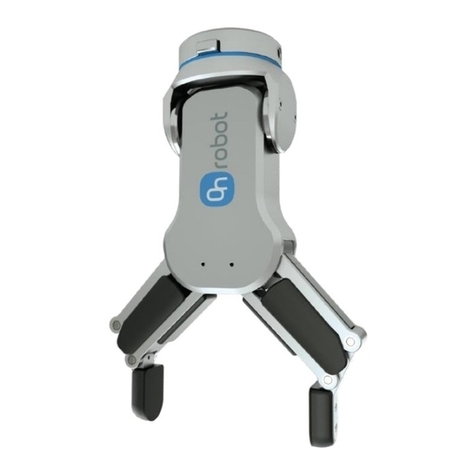
OnRobot
OnRobot DOOSAN Gecko Gripper user manual
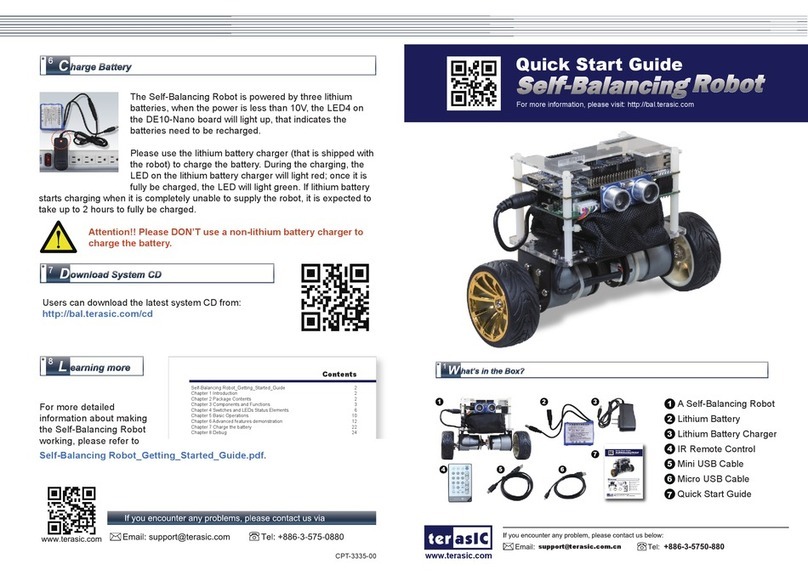
Terasic
Terasic Self-Balancing Robot quick start guide
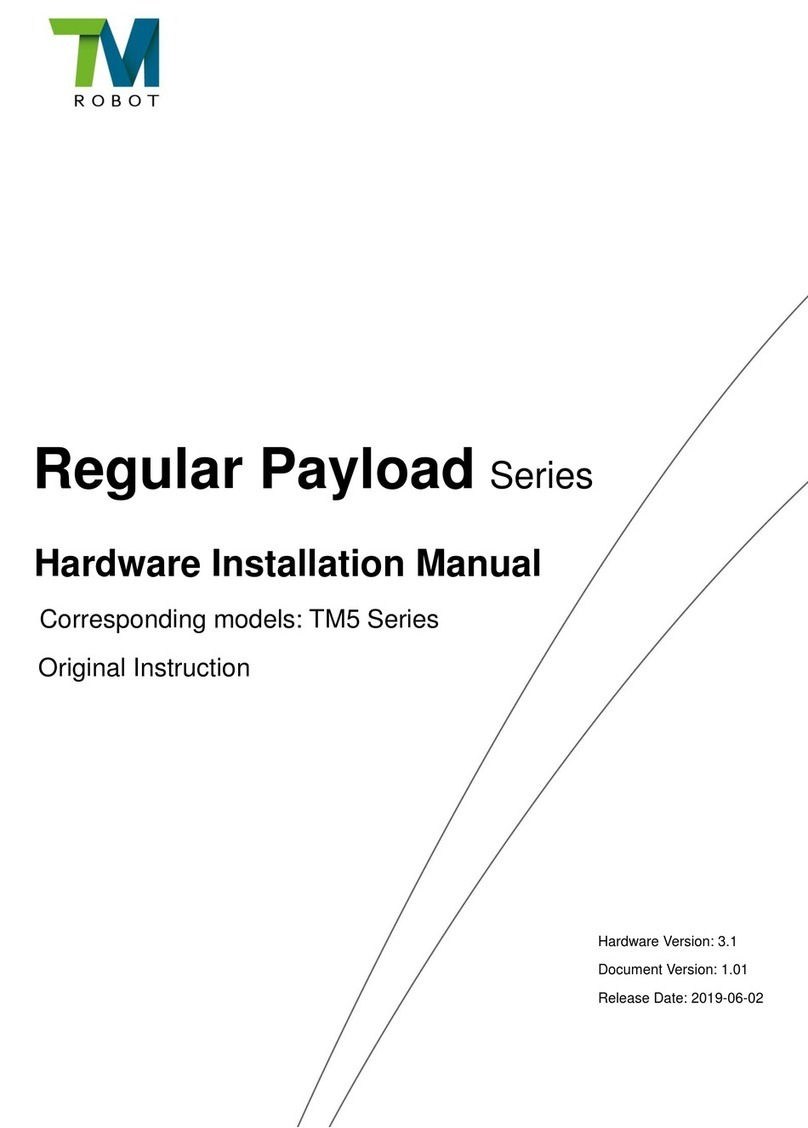
TM Robot
TM Robot Regular Payload Series Hardware installation manual
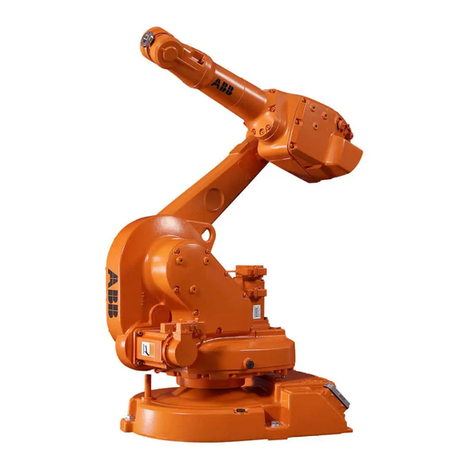
ABB
ABB IRB 1600 - 5/1,2 type A product manual

Eddyfi Technologies
Eddyfi Technologies INUKTUN MAGGHD user manual

